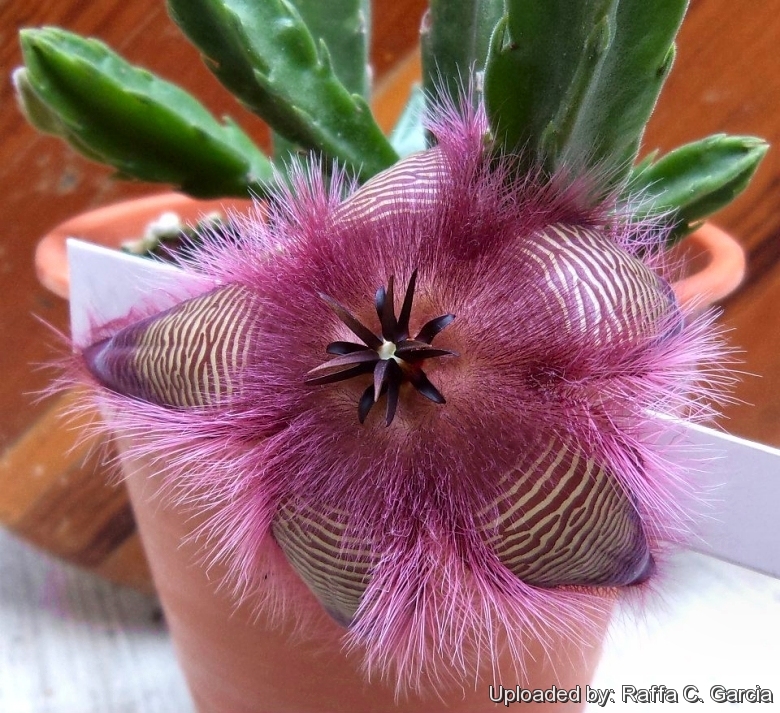
Stapelia hirsuta L. Photo by: Raffa C. Garcia
The dark-red flowers smell like a carrion and are covered by long setae that remember the fur of a dead animal , this way they attract flies for pollination (sapromyophily). The flowers are densely shaggy (hirsute) at the centre. Purplish colour simulate the rotting flesh of dead animals. These flowers attract beetles and carrion flies who pollinate the plant as they are fooled into trying to lay eggs on the flower.
Origin and Habitat: This species is in nature limited to the South/western Cape Province of South Africa.
Habitat: From winter rainfall area.
Synonyms:
See all synonyms of Stapelia hirsuta L.
back
Accepted name in llifle Database:Stapelia hirsuta L. L.Sp. Pl. 1: 217 (1753)Synonymy: 51
back
Common Names include:
ENGLISH: Carrion Plant, Starfish Flower, African starfish flowers, Hairy stapelia
Description: Stapelia hirsuta (a.k.a. African starfish flowers is best known for its foul-smelling flowers. It blooms a large star and it is 5 to 15 cm wide.
Notes: S. hirsuta is a very variable species with many hybrids both in the wild and in cultivation. Since the various forms are connected by intermediates it is extremely difficult to recognize infraspecific taxa.
Habit: Groundcover, clump forming.
Stem: Leafless, subquadrangular, ascending, usually fine-haired, green which redden in full sun and during the winter month.
Flower: Dark-red, flat and densely covered by long hair at the centre that remember the fur of a dead animal. At the base of young stems. Peduncle round. Corolla width very variable, from 5-15 cm (usually 10/12 cm) across and very deeply lobed. The moderate carrion smell of the flowers attracts flies which may lay eggs on the flower. Sometimes fly larvae that have hatched from the eggs can be seen on the flower.
Fruit: Flies pollinate the flowers resulting in the typical twin seed horns (follicles), which are decorative in themselves and often don't appear until a year later.
Seeds: The pant readily produces seed which germinates 100% if sown when fresh.
Phenology: Blossoming time: Flowers are freely produced throughout the late summer and autumn.
More...Subspecies, varieties, forms and cultivars of plants belonging to the Stapelia hirsuta group
Notes: S. hirsuta was (along with Stapelia variegata later transferred to the genus Orbea) the second stapeliads to be discovered. Linnaeus then described and set up the the new genus Stapelia in 1737 and based the genus on S. hirsuta that now stands for the type species of the genus.
Bibliography: Major references and further lectures:
1) Focke Albers, Ulrich Meve “Illustrated Handbook of Succulent Plants: Asclepiadaceae: Asclepiadaceae” Volume 4 Springer, 2002
2) Gideon Smith, Neil R. Crouch “Guide to Succulents of Southern Africa” Struik Nature, 01/nov/2009
3) Focke Albers, Ulrich Meve “Illustrated Handbook of Succulent Plants: Asclepiadaceae: Asclepiadaceae” Volume 4 Springer, 2002
4) Doreen Court “Succulent Flora of Southern Africa” CRC Press, 01/giu/2000
5) Clive Innes “Complete Handbook of Cacti and Succulents” Van Nostrand Reinhold Company, 01/dic/1981
6) A.C.White & B.Sloane “Stapelieae” ( White & Sloane) ed. 2 3: 855 Abbey San Encino Press, 1937
7) Luckhoff “The Stapelieae of Southern Africa” Capetown, A.A. Balkema 1952
8) Bruyns, P.V. 2005. “Stapeliads of southern Africa and Madagascar.” Vol. II. Umdaus Press, Hatfield.
9) James Cullen, Sabina G. Knees, H. Suzanne Cubey “The European Garden Flora Flowering Plants: A Manual for the Identification of Plants Cultivated in Europe, Both Out-of-Doors and Under Glass” Cambridge University Press, 11/ago/2011
More...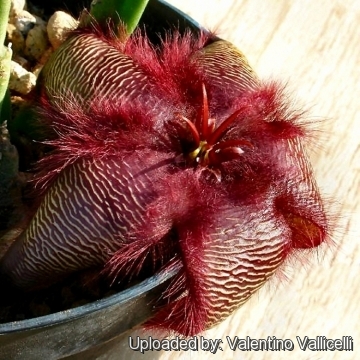 Stapelia hirsuta L. Photo by: Valentino Vallicelli
Stapelia hirsuta L. Photo by: Valentino Vallicelli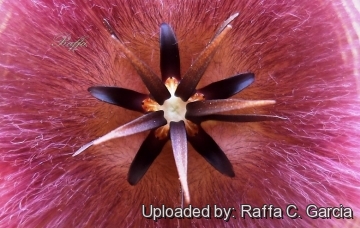 Stapelia hirsuta L. Photo by: Raffa C. Garcia
Stapelia hirsuta L. Photo by: Raffa C. Garcia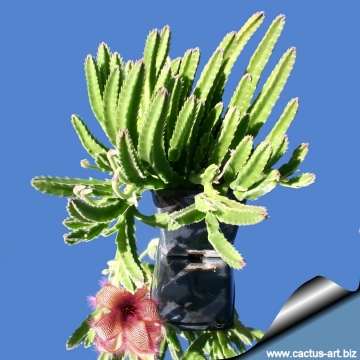 Stapelia hirsuta L. Photo by: Cactus Art
Stapelia hirsuta L. Photo by: Cactus Art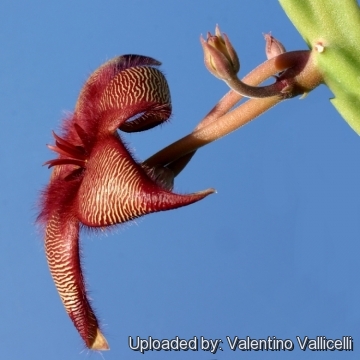 Stapelia hirsuta L. Photo by: Valentino Vallicelli
Stapelia hirsuta L. Photo by: Valentino Vallicelli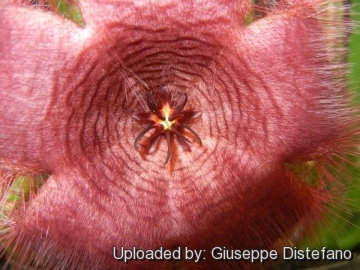 Stapelia hirsuta L. Photo by: Giuseppe Distefano
Stapelia hirsuta L. Photo by: Giuseppe Distefano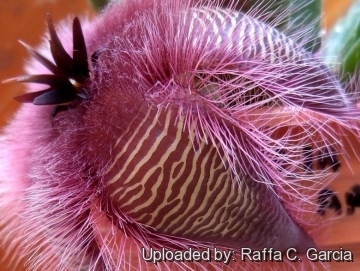 Stapelia hirsuta L. Photo by: Raffa C. Garcia
Stapelia hirsuta L. Photo by: Raffa C. Garcia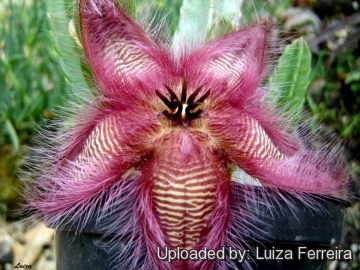 Stapelia hirsuta L. Photo by: Luiza Ferreira
Stapelia hirsuta L. Photo by: Luiza Ferreira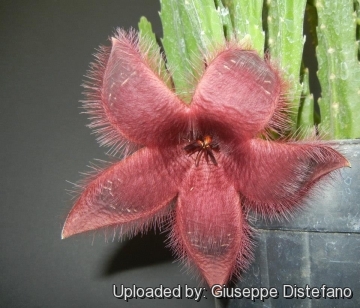 Stapelia hirsuta L. Photo by: Giuseppe Distefano
Stapelia hirsuta L. Photo by: Giuseppe DistefanoCultivation and Propagation: Together with Stapelia gigantea and Orbea variegataSN|19768]]SN|19768]], probably the most widely cultivated of stapeliads. It is an easy obliging blooming plant when mature, they are happy in any average succulent house.
Stapelia require moderately watering through the growing season but enjoy plenty of water and some fertiliser in hot weather, this helps them to flower freely. Water more sparingly in winter according to temperatures. But, as with most asclepiads, it is unwise to leave them wet in cold weather. Winter care presents no problems at 5°C with plenty of light. Since roots are quite shallow, use a cactus mix or add extra perlite or pumice to regular soil potting soil. A gritty, very free-draining compost is suitable, and clay pots help the plants to dry out between watering.
Sun Exposure: Partial sun or light shade
Pest and diseases: Stapelia species vary in their susceptibility to rotting, but are generally fairly easy to grow, especially if kept pest-free. They are very susceptible to stem and root mealy bugs, and damage from these may well initiate fungal attack. If you do have problems with a stem or with basal rotting, you can reliably isolate the healthy parts, dry them off, and re-root them in moist compost.
Cultural Practices: Re-pot every 2 years
Propagation: Easiest with stem cuttings. Allow cuttings to dry a day before planting. Stems must be laid (Not buried) on gritty compost and will then root from the underside of the stems. It can also be increased from seeds sowing in spring in moist, sandy peat moss. Barely cover seeds. Seeds germinate
More...
Your Photos
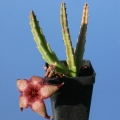
by Valentino Vallicelli
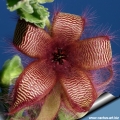
by Cactus Art





















